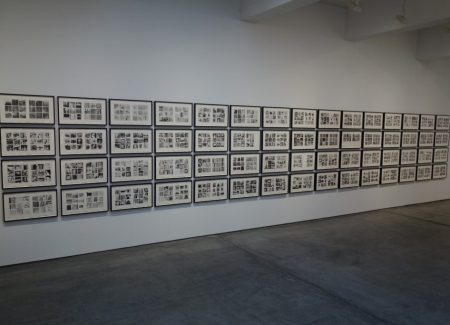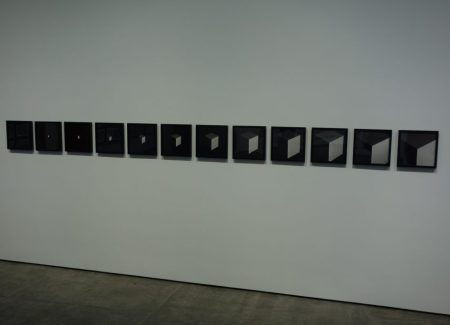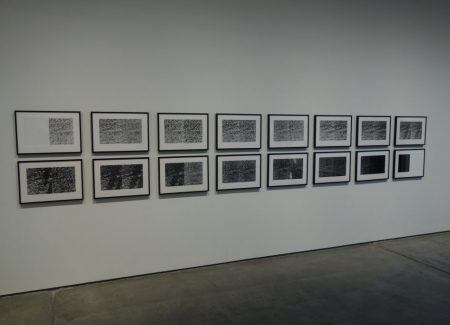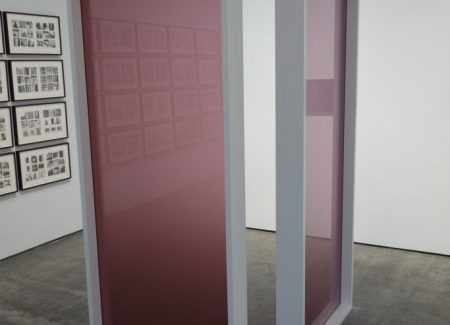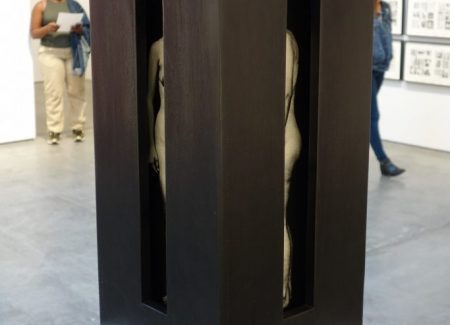JTF (just the facts): A two-venue paired show on view at Paula Cooper Gallery and Miguel Abreu Gallery (here), organized by Olivier Renaud-Clément.
At Paula Cooper, the works are shown against white walls in the main gallery space and the entry/reception area. 4 of the Sol LeWitt works are multi-image groups, as follows:
- Brick Wall: 16 digital prints, 1977/2010, each roughly 15×24
- Autobiography: 60 panels of black and white photographs (18 each), 1980, each board sized 12×22
- Cube: 12 gelatin silver pints, 1997, each 11×11, in an edition of 9+1AP
- A sphere lit from the top, four sides, and all their combinations: 28 inkjet prints, 2004, each sized 18×18, in an edition of 19+6AP
Other LeWitt photographic works on view include 6 cut black and white photographs, 1976, various sizes, 1 black and white photograph with cut out, 1979, sized roughly 16×16, and 1 sculpture made of painted wood, black and white photographs, and electrical wiring, 1963, sized 28x12x12. A side room includes several ink/pencil drawings and etchings.
The 2 Liz Deschenes works on view are pairs of UV prints on Plexiglas, 2016, each pane sized roughly 84×36. A side room includes one additional panel.
(Installation shots below.)
Editor’s note: While the details of the various works on view, the installation shots, and the open/close dates of the two exhibitions considered here are separate/different, the review merges the two into one overarching discussion. As such, the main body of the text in the two reviews is exactly the same, while the surrounding information specific to one venue or the other changes.
Comments/Context: This smart, two-venue show does something we hardly ever see anymore – it takes the work of an exciting contemporary photographer/artist, in this case Liz Deschenes, and deliberately puts it into dialogue with the work of an established master, in this case Sol LeWitt. For many, the usual default behavior for examining the work of our newest and most promising photographers is to gather them all together and then consider them as a single cohort, looking for similarities, differences, and most of all common trends, in the hopes of finding the threads that tie these innovative artists together. We are constantly trying to understand the new.
But what we don’t do often enough is take one of those artists out of that group of contemporaries and place his or her work in the context of an important figure of the previous generation. Doing so allows us to focus our attention on underlying connections, and those connections to the past enrich our understanding of the present. They encourage us to see how aesthetic and conceptual ideas have been shared, interpreted, and passed along, and how that evolution of common interests has manifested itself along the way. In short, the old opens the door to the new.
When we think of Sol LeWitt’s lasting contributions to the march of art history, his open cube sculptures/structures and his intricately detailed wall drawings deservedly come to mind first. But as seen in these shows, LeWitt’s lesser known works in photography probe many of the same issues, and do so with the same meticulous sophistication we associate with his more revered Conceptual Art exercises and Minimalist constructions.
LeWitt’s Brick Wall from 1977 (one the earliest photographic works in the show) offers a flavor for how he approached photography. In a series of 16 prints, LeWitt photographed the same patch of rough brick wall, each moment captured in an iterative gradation of light, from bright sun blasted white to shadowy darkness. Hung together, the prints offer both a carefully controlled, almost mechanistic monochrome transition (like a Zone System exposure chart) and a richly tactile study of surface and texture.
This interplay between conceptual precision and the properties of light (as photographed) would intrigue LeWitt for the rest of his life. His Cube from 1997 takes a simple, on-the-corner view of a cube (showing three distinct planes) and turns it into a step-by-step magnification exercise, where the tiny box becomes incrementally larger in each image, until the corner becomes an abstraction of three geometric fields. He applies a similar technique to a sphere in 2004, making an exhaustive taxonomy of the round object from every vantage point of light, exploring the multiplicative nuances of how light is cast. In both of these projects, LeWitt’s execution is highly structured, bringing an almost scientific attention to these elemental forms and surfaces.
In other series, LeWitt’s use of photography was more categorical, creating sprawling taxonomies of the details of his life (in Autobiography from 1980) and of everyday graffiti he found on the streets of New York (in On the Walls of the Lower East Side from 1979). Both of these works are rigorous and formal, framing the objects in his apartment and a parade of painted marks with crisp attention to space, geometry, and surface. Pipes, outlets, shoes, kitchen tools, clocks, books, houseplants – each gets its own category, each one identified and ordered as though he was just discovering the patterns and formal qualities hiding in the mundane. His images of graffiti feel the same – each letter, sign, or tag an addition to the surface or a gesture to be celebrated. By isolating these fragments, he systematizes our experience of them, pushing us back to seeing repetition, iteration, and evolution in the marks of the streets.
And in a few works, his own marks and interventions get more personal. Clouds of opaque black ink cover aerial maps of Manhattan, obscuring our ability to derive meaning from its horizontal and vertical structure. Cutouts do the same thing, either removing parts of the map in New York (a polygon constructed from points where he had lived), or removing the surroundings in aerial views of Florence, carving triangles and parallelograms out of the locations of major piazzas and churches. Here we see him using strict rules to govern his art making and reveling in the downstream purity of the resulting geometric forms.
With LeWitt’s photographic projects and series as a backdrop, Deschenes’ recent works feel surprisingly interlocked and congruent with many of his ideas, but pushed toward complete abstraction to a fuller extent. At first glance, her array of 9 triangles feels quite literal in its response to LeWitt, in its elemental geometric forms and rigid repetitions. But up close, each triangle dissolves into a wash of brown spots, drips, oxidations, and other surface variations, each one a tonal symphony of almost imperceptible marks. Our conclusions get more nuanced when we then bring in LeWitt’s graffiti findings nearby, with their isolation of intentional squiggles, stylized letters, and modified surfaces – Deschenes has brought process-based chance back into an equation where LeWit was removing it, allowing looseness to intrude where LeWitt was tightening his eye down, even when both were intent on investigating the subtleties of surface. Or perhaps Deschenes’ version of chance is more like the kind that influences LeWitt’s wall drawings, where environment, minutely imperfect instruction following, and human contact offer their own forms of intrusion.
Deschenes’ glowing pink rectangles respond to LeWitt on a different plane, exploring his interest in how light influences our perception of form. Once again, the surfaces of her works aren’t perfectly uniform, each having some amount of sparkly tonal variation, this time largely provided by transparency – depending on your viewing angle, the white of the walls or the grey of the floors of the gallery creates gradation and lightening/darkening across the already subtly tinted works. Conceptually, this resonates strongly with LeWitt’s nearby studies of light on a sphere or even his early brick wall iterations, where severe geometry is activated by the ever changing energy of light and shadow.
Given the intellectual richness of Deschenes’ work, it’s not surprising that when paired with LeWitt, a brainy back and forth gets going. Across the divide of decades, Deschenes is both affectionately reverent and smartly transformative, bowing to LeWitt but also making some of his ideas wholly her own. In her works, she’s made a strong argument that photographic conceptualism hasn’t somehow run its course, but can both effectively engage with the past and simultaneously move on to somewhere new.
Collector’s POV: The works in this show are priced as follows. The large LeWitt photographic groups are not for sale, while the Deschenes works are $220000 each. LeWitt’s photographic works have only been available intermittently in the secondary markets in recent years, with few of his larger sets coming up for sale. Prices have ranged between roughly $2000 and $40000. Deschenes’ work has very little secondary market history, so gallery retail remains the best/only option for those collectors interested in following up.
